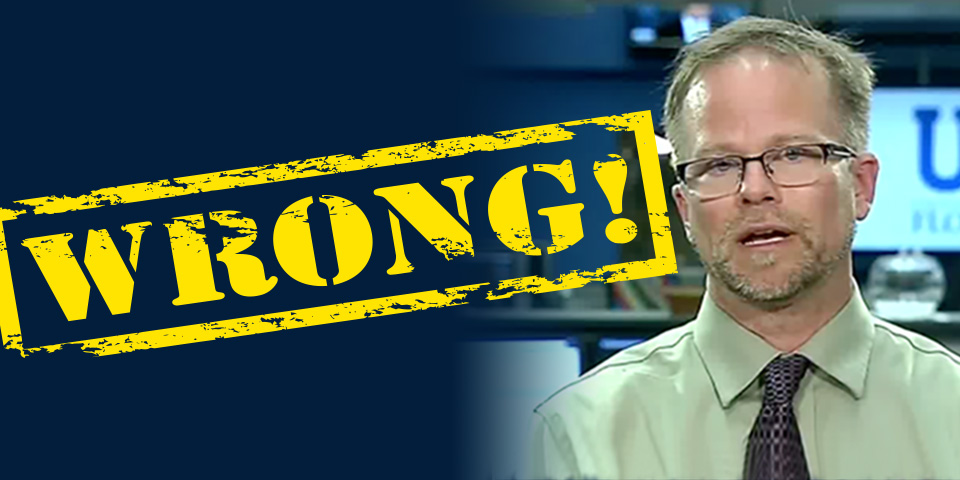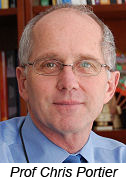
Folta’s claim that glyphosate is less toxic than cell phones and caffeine is "wrong", says cancer expert Prof Chris Portier. Report: Claire Robinson
Ever since the World Health Organisation cancer agency IARC classified glyphosate as a probable human carcinogen, we’ve been treated to a feast of spin from defenders of the chemical.
GMO and pesticide proponent Kevin Folta is among them. Folta was recently exposed as taking $25,000 from Monsanto for his “science communication” activities, contrary to his repeated claims of no connections with the company.
The glyphosate spinfest began soon after the IARC published its verdict. Monsanto issued a reassuring statement saying:
“IARC has classified numerous everyday items in Category 2 including coffee, cell phones, aloe vera extract and pickled vegetables, as well as professions such as a barber and fry cook.”
The implication is clear. We are all happy to eat pickled veg, drink coffee and use our mobile phones – and glyphosate’s no worse.
But Monsanto is misleading us. The company is confusing, apparently deliberately, the IARC categories 2A (probable carcinogen: limited evidence of carcinogenicity in humans and sufficient evidence of carcinogenicity in experimental animals) and 2B (possible carcinogen: limited evidence of carcinogenicity in humans and less than sufficient evidence in animals). Glyphosate is in 2A; coffee, cell phones, and many other everyday products are in 2B.
The campaign group Beyond GM called Monsanto’s statement “a silly and deliberate misrepresentation of IARC categories… The difference may sound subtle but it is significant. Being a 2A probable human carcinogen, in fact, puts glyphosate in the same league as human papillomavirus type 68, inorganic lead compounds, anabolic steroids, working in a petroleum refining plant, and the dry cleaning fluid tetrachloroethylene (perchloroethylene, or ‘perc’).”
Silly or not, every defender of glyphosate in the wake of the IARC’s verdict seems to have taken its cue from Monsanto. That includes the UK Science Media Centre, whose chosen “expert” Dr Oliver Jones stated that IARC also classifies night shifts as probable carcinogens, and alcoholic drinks and sunlight as known carcinogens.
Both Monsanto and the Science Media Centre are trivialising strong research on occupational cancer hazards. While the idea that “professions such as barber” are carcinogenic may sound laughable, hairdressing has been linked to increased cancer risk, thought to be as result of certain dark hair dyes that contained carcinogenic chemicals that have since been banned due to their carcinogenicity. And doing night shifts for long-term (though not short-term) periods is known to increase cancer (2) risk. So both factors are in IARC’s group 2A, for good reason.
Now Kevin Folta has jumped on the Monsanto disinformation bandwagon. In an interview with “biotech journalist” Mike Lewis about glyphosate, Folta stated:
"Glyphosate, according to the IARC, is less toxic than sunlight, cell phones, caffeine, table salt, and 10,000 times less of a risk for cancer as alcohol consumption.”
We asked Prof Chris Portier, a co-author of the IARC report on glyphosate, for his response. He said:
“This quote is wrong. The IARC review process identifies hazards but does not quantify them. The comparison suggested by Dr Folta's quote does not exist. However, some comparisons are possible, such as the evidence that glyphosate is carcinogenic is stronger than for cell phones (group 2B) and not as strong as that for alcohol (group 1).”
Folta’s claim about caffeine appears to be false. I could find no IARC classification of caffeine, an ingredient of coffee, after 1991, when it concluded it was “not classifiable as to its carcinogenicity to humans (Group 3)”. That means there was inadequate evidence for carcinogenicity.
Caffeic acid, which is present in coffee in minute amounts, is classified by IARC as a “possible” carcinogen, in group 2B. Brewed coffee is also grouped in 2B due to research that indicates it is “possibly carcinogenic to the human urinary bladder”.
So glyphosate (2A) is more toxic than caffeine (group 3) and cell phones (2B) – not, as Folta claims, less toxic. Sunlight’s group 1 status (known carcinogen) comes as no surprise to those of us who are bombarded with warnings to use suncream and avoid sunburn.
Folta fails to get the most basic of facts right – and his ‘mistakes’ appear always to be in the direction of letting industry’s poisons off the hook. No wonder Monsanto was happy to pay $25,000 to support his “science communication”.











